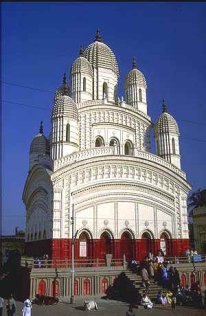
The Order of the White Moon Gallery Presents


Created by FireMaiden
 |
Kali is one of India's most popular goddesses. Her picture hangs in many homes. Calcutta is her temple city and derives its name from the Anglicized phrase Kali-Ghatt or "steps of Kali." The Goddess of Cemeteries was thought to thrive on blood. Goat blood rather than human blood was sacrificed to her and is still is in some parts of India. The Dark Mother and her children share a loving and intimate bond. The devotee is Her child and Kali is the ever-caring mother. |
SYMBOLISM
In Hinduism, all goddesses are ultimately one: Devi. She takes different forms to allow us to comprehend Her multiple possibilities. One of the most powerful is Kali.
Kali's blackness symbolizes Her comprehensive nature, as in black all colors merge. Just as all colors disappear in black, so all names and forms disappear in Her (Mahanirvana Tantra). Black can also represent the absence of color, signifying the nature of Kali as ultimate reality. Either way, Kali's color symbolizes Her transcendence of all form.
Kali's nudity has similar meaning. She is described as garbed in space or sky clad. In Her primordial nakedness, She is free from all covering of illusion. Her nudity represents totally illumined consciousness. Kali is the bright fire of truth, not hidden by the trappings of ignorance.
Kali is full-breasted. As our Mother, She creates endlessly. Her garland of fifty human heads, each representing one of the fifty letters of the Sanskrit alphabet, symbolizes knowledge and wisdom. Her girdle of severed human hands are the principal instruments of work and signify the action of karma. The binding effects of karma are overcome by devotion to Kali. She blesses devotees by cutting us free from the cycle of karma. Her white teeth are symbolic of purity and Her red tongue shows that She consumes all things and enjoys tasting what society regards as forbidden, Her indiscriminate enjoyment of all the world's flavors.
Kali's four arms represent the complete circle of creation and destruction. Her right hands, making the sign of fear not and conferring boons, represent Her creative aspect. Her left hands, holding a bloodied sword and a severed demon head, represent her destructive aspect. The bloodied sword and severed head symbolize the destruction of ignorance and the dawn of knowledge. The sword is the sword of knowledge, that cuts through ignorance and destroys false consciousness (the severed head). Her three eyes represent the sun, moon and fire, with which She observes the past, present and future. This is the origin of the name Kali, the feminine form of Kala, the Sanskrit word for Time.
The cremation ground, Kali's dwelling place, is where the five elements are dissolved. This symbolizes the dissolving of attachments, anger, lust and other emotions, feelings and ideas. The heart of the devotee is where this burning takes place and it is in her heart that Kali dwells. The devotee, under Kali's influence, burns away all limitations and ignorance. This inner cremation fire in the heart is the fire of knowledge, which Kali bestows.
The image of Shiva lying under the feet of Kali shows Shiva as the passive potential of creation. Kali is Shakti, the universal feminine creative principle and energizing force. Kali empowers Shiva. Shakti is expressed as the i in Shiva's name. Without the i, Shiva becomes Shva, which in Sanskrit means a corpse. So, without Shakti, Shiva is powerless or inert. This is the origin of the saying Shiva without Shakti is Shava.
 |
KALIGHAT IN CALCUTTA The original temple was a hut. A small temple was constructed by King Manasingha in the early 16th century. The current temple was completed in 1809. |
KALI TEMPLE AT DAKSHINESWAR In 1847, wealthy widow Rani Rasmani prepared to go on a pilgrimage to Banaras to express her devotion to the Divine Mother. The night before the pilgrimage, Kali intervened. She appeared to the Rani in a dream and said, There is no need to go to Banaras. Install my statue in a beautiful temple on the banks of the Ganges and arrange for my worship there. Then, I shall manifest myself in the image and accept worship at that place. Profoundly affected by the dream, the Rani immediately purchased land, and began construction of the temple. The centerpiece of the temple complex is a shrine dedicated to Kali. |
 |
Kali first appears in the Devi Mahatmya (Glory of the Goddess), a fifth to sixth century text. With this writing, worship of the Goddess took on dramatic new dimensions. She is not only the Source of life, She is the very earth, all-creating and all-consuming.
Kali's most famous appearances are found in the Devi Mahatmya. Early in battle, demons Canda and Munda approach Goddess Durga with weapons drawn. Seeing them prepared to attack, Durga becomes infuriated and Her face turns dark as ink. Suddenly, Kali springs from Durga's forehead. She roars loudly and leaps into battle, tearing demons apart with Her bare hands and crushing them in Her teeth. In one furious blow, Kali decapitates the two demon generals with Her sword.
Later in the same battle, Kali is again summoned by Durga to help defeat the demon Raktabija. This demon reproduces himself instantly whenever a drop of his blood touches the ground. Having repeatedly wounded Raktabija, Durga and the Goddesses assisting Her find they have made their situation worse. As Raktabija bleeds more and more profusely from his wounds, the battlefield becomes filled with Raktabijas. Kali defeats the demon by sucking the blood from his body and throwing the countless Raktabijas into Her gaping mouth.
In these two battles, Kali represents Durga's personified wrath. Kali plays a similar role with Parvati. Parvati is a benign Goddess, but from time to time She exhibits fierce aspects. When this occurs, Kali is sometimes described as being brought into being. In another tale, Shiva asks Parvati to destroy the demon Daruka, who can only be killed by a female. Parvati then enters Lord Shiva's body, transforms herself and reappears as Kali. She attacks and defeats Daruka and his minions. Kali becomes so intoxicated with blood lust that She threatens to destroy the entire world in Her fury. Shiva intervenes and calms Her.
Although Kali can be softened by Shiva, there are times when She incites Shiva to dangerous, destructive behavior. One tradition tells of a dance contest between the two. After defeating demons in battle, Kali takes up residence in a forest with her retinue of fierce companions, terrorizing the surrounding area. A devotee of Shiva who was distracted from prayers and offerings, asks Shiva to rid the forest of the violent Goddess. When Shiva appears, Kali threatens Him, claiming the area as Hers. Shiva challenges Her to a dance contest and defeats Her when She is unable to match His energetic dance.
Worship
Worship of Kali takes many forms. One form is puja, or showing reverence through invocation, ritual and prayer. The rituals of Kali puja are plain and simple. Elaborate cooking or preparation is not needed to satisfy Kali. Even pure wine is offered to Kali.
Festival of Diwali
Diwali is the Hindu New Year. Women decorate their homes with rice paintings and sand mandalas; men light clay lamps to show their ancestors the path to heaven. Children shoot off fireworks. More than one billion Hindus all over the world celebrate the new year with fun, food and festivities. For good luck, they worship Kali, the Universal Mother Goddess, seeking Her blessing on this new moon night in October or November.
Diwali is the celebration of the victory of good over evil. Everyone, early in the morning of this festival of light, greets their families and friends, forgetting and forgiving the wrongdoings of others. They take an oil bath, prepare sweet meats and pray to Kali to destroy their ignorance as well as grant boons. The night sky is lit with fireworks to chase away evil spirits.
Diwali is the harvest celebration for the farmers. They place oil lamps in the rice fields to kill seasonal insects and offer fruit, flowers, fragrances and food to Kali, the Sustainer of Life. Also on this day, Hindu merchants open their new account books and pray to the Divine Mother for success and prosperity during the coming year. The Kali festival is Mother's Day in India, when Indian women are presented with new clothes and jewelry and treated with great reverence.
Temples dedicated to Kali are freshly painted, decorated with neem and mango leaves and glow with glittering lights at night. Offerings of cooked rice and curd are brought in pots for Kali.
The mantra Om Kali Ma vibrates with Her power and transports you to Her domain. With every inhalation say to yourself silently Om Kali Ma and feel Her infuse your body with Her power, radiance and love. With every exhalation, silently breathe out Om Kali Ma and feel Her presence fill the universe around you. Breathe in Om Kali Ma and drink in Her elixir. Breathe out Om Kali Ma and float like a bubble in the ocean of the Divine. Allow your ego to sleep and the Divine to awaken within you.
Kali teaches that pain, sorrow, decay, death, and destruction are not overcome by denying or explaining them away. These are inevitable parts of life and denying them is futile. For us to realize the fullness of our being and to realize our potential, we must accept these parts of existence. Kali's gift is freedom. The freedom of the child to revel in the moment, obtained only after confrontation with or acceptance of death. Kali is Mother, not because She protects us from the way things are, but because She reveals our mortality to us and releases us to act fully and freely; She releases us from the web of pretense, practicality and rationality.
Of all the Devi forms, Kali is the most compassionate because She provides liberation to Her children. A soul who engages in spiritual practice to remove the illusion of the ego sees Mother Kali as sweet, affectionate, and overflowing with love for Her children.
If you need to see a situation with crystal clarity, Kali can help you discern the reality behind the illusion and perceptions. This ritual should be performed during the waxing moon for an increase in clarity and perceptiveness. It can be modified to ask Kali to banish things that are in the way of your seeing clearly. When used as a banishing, perform it during a waning moon and substitute a second black candle for the white candle.
ITEMS NEEDED:
RITUAL BODY:
Sources: